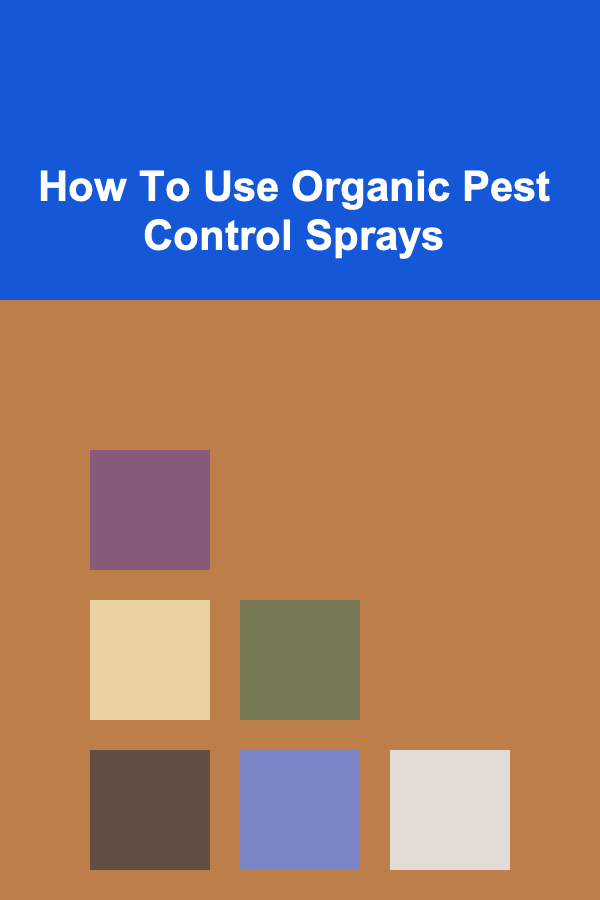
How To Use Organic Pest Control Sprays
ebook include PDF & Audio bundle (Micro Guide)
$12.99$9.99
Limited Time Offer! Order within the next:

In recent years, organic gardening and sustainable farming have gained popularity as people become more aware of the environmental impact of traditional pest control methods. Synthetic pesticides, while effective in controlling pests, often pose a risk to non-target species, pollute water sources, and harm soil health. Organic pest control sprays, on the other hand, offer a natural alternative that is safer for the environment and beneficial insects while still being effective against harmful pests.
In this article, we will explore how to use organic pest control sprays, why they are an important tool for gardeners and farmers, and the best practices for applying them. We will also cover the types of organic sprays available, their ingredients, and their effectiveness in controlling different kinds of pests.
What Are Organic Pest Control Sprays?
Organic pest control sprays are formulations made from natural ingredients designed to control or eliminate pests without the use of harmful chemicals. Unlike conventional pesticides, organic sprays are typically derived from plants, minerals, or other naturally occurring substances. These sprays are generally less toxic to beneficial insects, animals, and humans, making them a safer choice for organic gardening and farming practices.
Organic pest control sprays can target a wide range of pests, including insects, fungi, and even some types of rodents. They work in several ways: by repelling pests, disrupting their reproductive cycles, or directly killing them. The effectiveness of organic pest control depends on various factors, such as the type of pest, the plant being treated, and the environmental conditions.
Types of Organic Pest Control Sprays
There are several types of organic pest control sprays available, each designed to target specific pests or types of damage. Some of the most common types include:
1. Neem Oil
Neem oil is one of the most widely used organic pest control products. It is derived from the seeds of the neem tree (Azadirachta indica) and contains compounds that act as natural insecticides. Neem oil disrupts the hormonal systems of pests, making it difficult for them to feed, reproduce, or grow. It is effective against a wide range of insects, including aphids, mealybugs, whiteflies, and spider mites. Neem oil is also an effective fungicide and can help prevent fungal diseases like powdery mildew.
How to use neem oil spray:
- Mix neem oil with water according to the manufacturer's instructions (usually 1-2 tablespoons of neem oil per gallon of water).
- Add a few drops of mild dish soap to help the oil mix with water.
- Spray the solution on both the upper and lower sides of the plant leaves, ensuring thorough coverage.
- Apply the spray in the early morning or late evening to avoid direct sunlight, which can cause the oil to burn the plants.
- Reapply every 7 to 14 days, or after rain, for best results.
2. Diatomaceous Earth (DE)
Diatomaceous Earth is a natural substance made from the fossilized remains of diatoms, microscopic algae. It works as a physical insecticide by damaging the exoskeletons of insects. When insects come into contact with DE, it scratches and dries out their outer layer, ultimately leading to dehydration and death. DE is effective against a variety of pests, including ants, cockroaches, slugs, and fleas.
How to use diatomaceous earth spray:
- Mix diatomaceous earth with water to create a slurry (the recommended ratio is typically 1 cup of DE per gallon of water).
- Shake the mixture well and pour it into a spray bottle or garden sprayer.
- Spray the solution directly onto the target areas, focusing on places where pests are most active, such as around the base of plants, cracks in the soil, or entry points for insects.
- DE is most effective when applied in dry conditions, so avoid spraying it in heavy rain or on wet surfaces.
3. Insecticidal Soap
Insecticidal soap is made from potassium salts of fatty acids and is an effective way to control soft-bodied insects such as aphids, mealybugs, and whiteflies. The soap works by breaking down the cell membranes of the insects, causing them to dehydrate and die. Insecticidal soap is non-toxic to humans, pets, and beneficial insects like ladybugs and bees.
How to use insecticidal soap:
- Mix the insecticidal soap according to the label instructions (usually 2 to 5 tablespoons per gallon of water).
- Spray the solution directly onto the infested plants, covering both the tops and bottoms of the leaves.
- Reapply the spray every 3 to 7 days or as needed to control the pest population.
4. Garlic and Hot Pepper Spray
Garlic and hot pepper sprays are homemade organic pest control solutions that can deter a wide variety of pests, including insects and animals. The strong odors of garlic and hot peppers act as natural repellents, preventing pests from feeding or approaching the plants.
How to use garlic and hot pepper spray:
- Blend 1 bulb of garlic and 1 to 2 hot peppers with a quart of water.
- Strain the mixture to remove solid pieces and pour the liquid into a spray bottle.
- Add a small amount of mild dish soap to help the solution adhere to the plants.
- Spray the solution on plants that are affected by pests.
- Reapply every 7 to 10 days, or after heavy rain.
5. Essential Oil Sprays
Essential oils like eucalyptus, peppermint, lavender, and citronella are known for their pest-repelling properties. They work by emitting strong scents that repel insects or disrupt their sense of smell. Essential oil sprays are safe for humans and pets when used properly and can be effective against flies, mosquitoes, ants, and even rodents.
How to use essential oil spray:
- Mix 10-15 drops of your chosen essential oil(s) with water (about 1 cup) in a spray bottle.
- Add a few drops of dish soap to emulsify the oils in the water.
- Spray the solution on plants, particularly the leaves and stems, as well as around entryways and areas where pests are common.
- Reapply every few days or after rainfall.
6. Rotenone and Pyrethrin
Rotenone and pyrethrin are naturally derived insecticides. Rotenone is obtained from the roots of tropical plants like Derris and Lonchocarpus, while pyrethrin comes from the flowers of the chrysanthemum plant. Both chemicals disrupt the nervous systems of insects, causing paralysis and death. While effective, both should be used with caution, as they can also affect beneficial insects if not applied carefully.
How to use rotenone and pyrethrin:
- Follow the manufacturer's instructions carefully, as the concentrations and dilution rates can vary.
- Apply early in the morning or late in the evening to reduce the risk to beneficial insects.
- Avoid using these sprays when pollinators like bees are active.
Best Practices for Using Organic Pest Control Sprays
While organic pest control sprays offer a safer and more environmentally friendly solution than synthetic pesticides, they should still be used correctly to ensure their effectiveness and minimize any negative impact on the environment. Here are some best practices to follow when using organic pest control sprays:
1. Choose the Right Spray for the Pest
Different pests require different types of treatments. Before applying any spray, identify the pest you are dealing with and choose the appropriate organic spray that targets that specific pest. For example, neem oil works well against aphids and whiteflies, while diatomaceous earth is effective for controlling slugs and beetles.
2. Test the Spray on a Small Area First
Before applying any organic spray to your entire garden or crop, test it on a small section of the plant first. This will allow you to observe any adverse effects, such as leaf burn or discoloration, and adjust your method if needed.
3. Apply at the Right Time
Timing is crucial when applying organic pest control sprays. Some sprays, like neem oil and insecticidal soap, are best applied in the early morning or late evening when the sun is not as intense. This helps prevent plant damage and ensures that the spray has enough time to work before the heat of the day.
4. Follow the Label Instructions
Even though organic sprays are generally safer than synthetic pesticides, they can still cause harm if not used correctly. Always follow the manufacturer's instructions regarding dilution rates, application frequency, and safety precautions.
5. Rotate Your Sprays
To prevent pests from developing resistance, rotate the use of different organic pest control sprays. This also helps target a wider range of pests and reduces the likelihood of a pest population becoming resistant to a single treatment.
6. Use Sprays as Part of a Holistic Pest Management Plan
Organic pest control sprays should be part of an integrated pest management (IPM) strategy. IPM involves using a combination of techniques, including crop rotation, introducing beneficial insects, and maintaining healthy soil, to keep pests in check. Relying solely on sprays may not be enough to manage pest populations in the long term.
7. Avoid Overuse
While organic pest control sprays are generally safer than synthetic pesticides, overuse can harm beneficial insects, soil health, and plant health. Use these sprays as needed and try to minimize their impact on the broader ecosystem.
Conclusion
Organic pest control sprays are a valuable tool for gardeners and farmers who want to protect their crops from harmful pests without resorting to harmful chemicals. By choosing the right sprays, applying them at the right time, and following best practices, you can maintain a healthy, sustainable garden or farm that is both pest-free and eco-friendly.
With the rise of organic gardening and sustainable farming practices, using natural pest control methods will continue to be an essential part of creating a healthier, more balanced environment. By embracing organic pest control sprays, we can reduce our reliance on synthetic chemicals and ensure a safer future for our plants, our communities, and the planet.

How to Build a Checklist for Conducting Initial Phone Interviews
Read More
How to Build a Checklist for Structuring Your Business Presentation
Read More
How to Market Your Rental Property Effectively
Read More
How to Review and Adjust Your Budget Regularly
Read More
How to Travel as a Couple on a Budget
Read More
How to Develop a Strong Anti-Procrastination Habit
Read MoreOther Products

How to Build a Checklist for Conducting Initial Phone Interviews
Read More
How to Build a Checklist for Structuring Your Business Presentation
Read More
How to Market Your Rental Property Effectively
Read More
How to Review and Adjust Your Budget Regularly
Read More
How to Travel as a Couple on a Budget
Read More